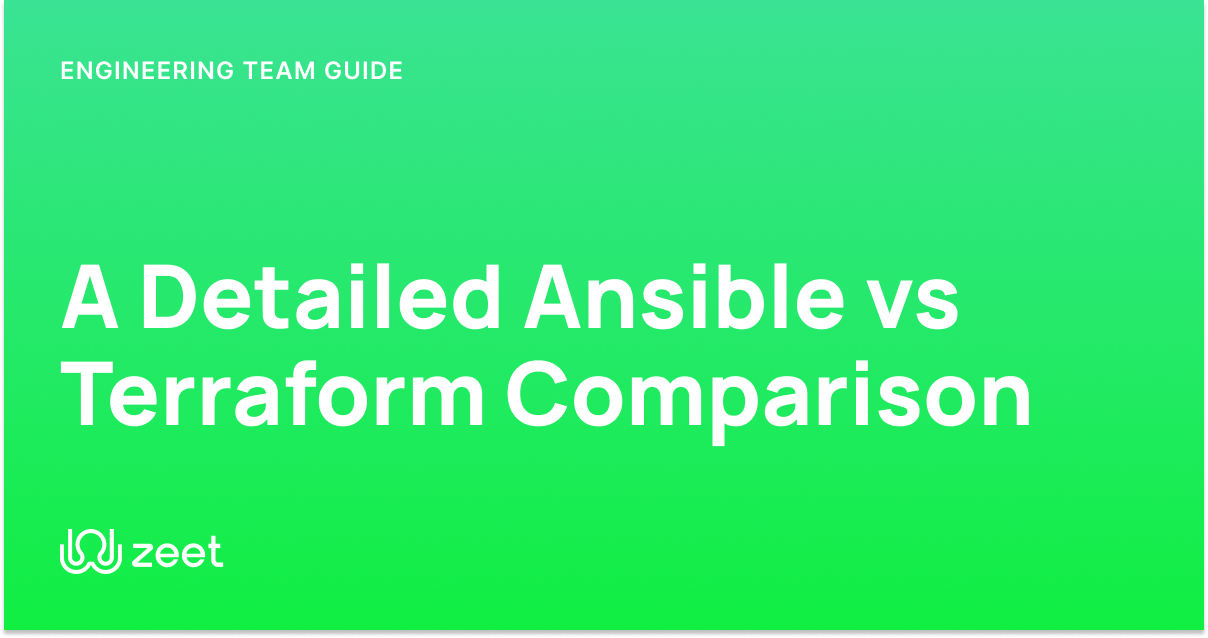Are you wondering what Terraform import existing Resources is all about? In this blog, you will learn how to import existing resources into Terraform, which is immensely helpful when managing infrastructure as code. This guide gives you a step-by-step approach on how to do this. What is Terraform? Dive in and find out!
Introduction to Terraform Import

Terraform is a tool that allows you to define and manage your infrastructure as code (IaC). This means that instead of clicking around in a cloud provider's UI like a caveman, you can write code to create, update, and delete resources like VMs, databases, and networking configurations.
Terraform then translates this code into actual cloud resources, making it easier to version control, collaborate, and reproduce your infrastructure. Terraform isn't just for cloud platforms, by the way. You can use Terraform to manage on-prem solutions too, but it's especially popular for cloud services like AWS, Google Cloud, and Azure.
Terraform `import` Command
You can use Terraform to create new infrastructure resources from scratch, but what if you already have resources in your cloud provider? That’s where the `terraform import` command comes into play. With this command, you can target a specific resource that already exists in your cloud provider and map it to a resource you've defined in code. This makes it easier to transition existing infrastructure to Terraform, combine existing resources with new ones, and manage everything in a single place.
Maximizing Cloud and DevOps Efficiency with Zeet
Zeet helps you get more from your cloud, Kubernetes, and Terraform investments. By using Zeet as your CI/CD and deployment platform, your engineering team can become strong individual contributors who help your business grow.
Contact Zeet to learn more about how Zeet can help you get seamless cloud deployments every time, and how Zeet can help your team become a top-performing engineering team.
Related Reading
Why Import Existing Resources?

When transitioning from another infrastructure as code (IaC) provider to Terraform, you may have existing resources that need to be managed with Terraform. Importing existing resources into Terraform allows you to seamlessly integrate these resources without rebuilding them from scratch.
Leveraging Web Console-Created Resources
Sometimes resources are created directly in the web console, bypassing the Terraform configuration. Importing these existing resources into Terraform enables you to maintain the desired state of the infrastructure and manage all resources as code.
Migrating Infrastructure Without Downtime
During infrastructure migrations, you may need to move existing resources from one environment to another without any downtime. Importing existing resources into Terraform allows you to orchestrate the migration process efficiently while ensuring the continuous operation of your infrastructure.

Terraform Import Basics

To import a resource, you first need to write a resource block for it in your configuration, establishing the name by which it will be known to Terraform. Then, you can use the terraform import command to attach the existing settings of the resource to the name you specified. For example, to import an AWS instance with ID "i-abcd1234" into the aws_instance resource named "example", you would run terraform import aws_instance.example i-abcd1234.
Always ensure that each remote object managed by Terraform is bound to only one resource address. If you import existing objects into Terraform, be wary of importing the same object multiple times, as Terraform may exhibit unwanted behavior.
Terraform Import Existing Resources on Terraform v1.5.0 and Newer

Exciting Changes in Terraform v1.5.0
Terraform 1.5.0 brings two major new features that significantly improve the infrastructure as code workflow:
Config-Driven Import
Terraform 1.5 introduces a new config-driven import mechanism, which allows you to define import operations directly in your Terraform configuration using a new import block. This is a significant improvement over the previous terraform import command, which had several limitations:
- Import operations can now be executed as part of the standard plan and apply cycle, making the process more predictable and less error-prone.
- Terraform can automatically generate the matching resource blocks for the imported resources, dramatically reducing the manual effort required. As one customer put it, "this is going to save us weeks and weeks of work."
Checks
Terraform 1.5 also introduces a new check block, which allows you to define custom functional validations for your provisioned infrastructure. This goes beyond the existing precondition and postcondition features, providing a more holistic way to ensure the real-world infrastructure matches your expectations.
Importing an AWS IAM Role and Policy
The first step to importing an AWS IAM role and policy is to define the import block in your Terraform configuration.
Here's an example of how to do this:
Now, when you run terraform import, Terraform will create these resource blocks in your configuration automatically. The next step is to define the actual policy document for this imported AWS IAM policy.
Identifying Resources for Import and Creating an Import Block in Terraform Configuration
The first step is to identify the resources you want to import. You can do this by using the terraform state list command to show all the resources Terraform is currently managing.
The next step is to create an import block in your Terraform configuration for each resource you want to import. The import block specifies the type of resource to import, the name of the resource within your configuration, and any required arguments to uniquely identify the imported resource.
Here's an example:
In this example, the import block associates the imported AWS instance with the aws_instance resource named "web" in your configuration. The id argument specifies the ID of the imported instance.
Related Reading
- Terraform Apply Auto Approve
- Terraform Module
- Terraform vs Cloudformation
- Terraform AWS Security Group
- Terraform Kubernetes Provider
- Terraform AWS Lambda
- Datadog Terraform
- Terraform Cloud Pricing
- Terraform IAM Role
- Terraform Debug
- Terraform Docker
- Github Actions Terraform
- Terraform ECS
- DevOps Terraform
- Terraform Automation
- Terraform CI CD
- Terraform Workflow
- Terraform Security
- Terraform Orchestration
- Terraform Multi Cloud
- Terraform No Code Provisioning
- Terraform Migrate State
- Terraform State Management
- Terraform AWS RDS
- What is Terragrunt
- Terragrunt vs Terraspace
- Terraform Multiple Environments
- Terraform Multiple Users
- Upgrade Terraform Version
- Terraform Test
- Terraform Commands
- Terraform Alternatives
- Terraform Stacks
- Crossplane Vs Terraform
- Terraform Import
- Terraform Tutorial
- Terraform for_each
- Terraform Dynamic Block
Generating Terraform Import Configuration Automatically

Automated Terraform Import makes it simpler and easier for you to manage your AWS resources as infrastructure as code (IaC). Manually importing AWS resources to Terraform by using the ‘Terraform Import’ command requires a lot of care and attention, which normally translates to a considerable amount of time and effort.
A Terraform Import engine can seamlessly identify which AWS resources are not managed by Terraform and with a single click, generates Terraform code for them. This saves you a significant amount of time and effort, streamlining the process of importing existing resources into your Terraform configuration.
Get Seamless Cloud Deployments with Zeet
Zeet helps you to get more from your cloud, Kubernetes, and Terraform investments and helps your engineering team become strong individual contributors through our CI/CD & deployment platform.
Contact Zeet to learn more about how Zeet help you get seamless cloud deployments every time, and helps your team to become a top-performing engineering team.
Potential Challenges With Terraform Import
When importing resources into Terraform, it's crucial to have the exact resource ID to avoid misalignment between your configuration and the imported resources. Each Terraform resource in the AWS provider expects a specific physical ID when importing, and some resources even expect a tuple of identifiers. This precision is necessary to ensure that the intended state aligns with the actual resources in use.
Terraform State Synchronization
Post-importing resources, it's essential to run the Terraform Plan command to validate and synchronize the Terraform configuration file with the actual resources. This step helps to identify any drifts between your manual configuration and the real-world resources. Drifts, or discrepancies, can lead to unwanted behavior or unexpected outcomes when applying changes.
Manual Configuration Writing
A common challenge with Terraform imports is that the tool does not automate the generation of configuration files. As a result, you need to manually create the configuration for the imported resources. This process can be time-consuming and error-prone, involving steps such as finding the resource in the AWS console, referring to Terraform documentation, and carefully copying attributes. The manual configuration writing can become cumbersome, especially for large-scale infrastructure with numerous resources.
Risk of Downtime or Data Loss
Importing external resources into Terraform can pose the risk of downtime or data loss if not carefully managed. Errors during the import process or misalignments between the configuration and actual resources can lead to unwanted consequences. It's crucial to handle the import process diligently to minimize risks and ensure the stability of your infrastructure.
Difficulty with Large-Scale Infrastructure
The manual configuration writing required for Terraform imports can make the process challenging for large-scale infrastructures with numerous resources. Managing a significant number of resources manually can be time-consuming and cumbersome, making it harder to efficiently import resources at scale. This challenge highlights the need for better automation and tooling support to streamline the import process for complex environments.
Related Reading
- Atlantis Terraform
- Terraform Tools
- Terraform Cloud Alternatives
- Spacelift vs Terraform Cloud
- Atlantis Alternatives
- Scalr vs Terraform
- Env0 vs Terraform Cloud
- Terraform Testing Tools
- Ansible vs Terraform
- Terraform vs Ansible

Become A Top Performing Engineering Team With Zeet's CI/CD & Deployment Platform for Kubernetes and Terraform
Zeet is a remarkable solution that enhances the efficiency of your cloud, Kubernetes, and Terraform investments. With Zeet, your engineering team will develop into strong individual contributors through the CI/CD & deployment platform. This allows every member of your team to achieve successful cloud deployments every time, ultimately propelling them towards engineering excellence.
Zeet supports your team in getting more out of the investments you have made in cloud services, Kubernetes, and Terraform. To unlock the full potential of your engineering team, reach out to Zeet and discover how your team can reach new heights in cloud deployments.
Are you wondering what Terraform import existing Resources is all about? In this blog, you will learn how to import existing resources into Terraform, which is immensely helpful when managing infrastructure as code. This guide gives you a step-by-step approach on how to do this. What is Terraform? Dive in and find out!







.png)

